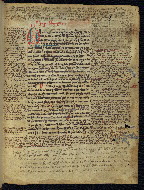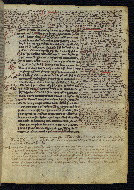Home > Digitized Walters Manuscripts
This document is a tranformation of a TEI P5 XML manuscript description incorporating images. If you have trouble reading special or non-Latin characters on this page, please make sure you have appropriate Unicode fonts installed and an up-to-date web browser.
Walters Ms. W.66, Compendium of scientific works including Aristotle
Browse images (Browse images in a new window) | TEI in XML format
W.66
Compendium of scientific works including Aristotle
Authority name: Aristotle
Authority name: Frederick II, Holy Roman Emperor, 1194-1250
Authority name: Alfred, of Sareshel
Known as: Alfredus Anglicus
Authority name: Aristippus, Henricus, fl. 1156-1162
Authority name: Qusṭā ibn Lūqā, ca. 820-ca. 912
Known as: Costa ben Luca
Authority name: Nicolaus, of Damascus
Authority name: Joannes, Hispalensis, 12th cent
Authority name: William, of Moerbeke, ca. 1215-1286
Authority name: Averroës, 1126-1198
Authority name: Kindī, d. ca. 873
As-written name: ysaac filii iacob alchindi
Authority name: Rāzī, Abū Bakr Muḥammad ibn Zakarīyā, 865?-925?
Known as: Rasis
This thirteenth-century scholar’s text appears to be a composite of various smaller booklets, written in a variety of different places and times; the script, layout, and even parchment type change drastically from one section to the next. It contains Latin translations of several scientific works of Aristotle, along with other works by a variety of authors. Those additional authors, who are primarily medieval and represent a wide range of scholars who engaged with Aristotle across both time and place, include Frederick II, Holy Roman Emperor (1194-1250), Alfred of Sareshel (also known as Alfredus Anglicus, a 13th century English scholar), Henricus Aristippus (fl. 1156-1162), Qusṭā ibn Lūqā (ca. 820-912, known as Costa ben Luca), Nicolaus of Damascus (b. 64 BCE), Joannes Hispalensis (12th century), William of Moerbeke (ca. 1215-1286), Averroës (1126-1198), Kindī (d. ca. 873, and name written in text as ysaac filii iacob alchindi), and Rāzī, Abū Bakr Muḥammad ibn Zakarīyā (865?-925?). The majority of the texts, and the abundance of marginal notes and glosses that accompany them, were probably produced in England, France, or Spain, but the last folios and many of the notes seem to be of Italian origin, suggesting a text that was well traveled in addition to being well read.
13th century CE
Italy, and England, France, or Spain
Book
Scientific
Philosophical
The primary language in this manuscript is Latin.
Parchment
Of varying types, ranging from fine and smooth to thick and coarse, and from creamy white to yellow; the final folios (fols. 235-243) likely of Italian origin and thicker than the rest, with hair follicles visible
Foliation: i+244+i
Foliated in pencil on upper right rectos; numbered 1-243, with fol. 113 repeated (second noted as 113*)
Formula: 1-5(8), 6(12,-4,-5), 7(10), 8(12), 9(10), 10(12), 11(10), 12-15(12), 16(8), 17(10), 18-19(14), 20(4,-2), 21-22(12), 23(10), 24(8), 25(2,-2)
Catchwords: Catchwords visible on fols. 127v (partly) and 139v (wholly)
Signatures: In pencil, on interior corner of first and last folio of each quire
Comments: Quires begin on fols. 1(1), 9(2), 17(3), 25(4), 33(5), 41(6), 51(7), 61(8), 73(9), 83(10), 95(11), 105(12), 116(13), 128(14), 140(15), 152(16), 160(17), 170(18), 184(19), 198(20), 201(21), 213(22), 225(23), 235(24), 243(25)
14.5 cm wide by 19.2 cm high
6.7 cm wide by 11.0 cm high
- Columns: 1
- Ruled lines: 30
- This general layout applies to the majority of the texts, but many parts are slightly or wholly different, as follows: fols. 1r-32v (quires 1-4) ruled with 27 lines; fols. 46r-47v (singletons glued into a quire) have 54 lines and measure 13.5 x 10 cm; fol. 72v does not appear to be ruled, and is 12 cm wide; fols. 148r-151v are not ruled, and the size of the written surfaces is irregular; fols. 152r-159v (quire 16) have 35 lines and measure 14 x 8.5 cm; fols. 160r-187r have 22-27 lines, and measure 11.5 x 6.5 cm; fols. 187v-192v have 36 lines and measure 13.7 x 10 cm; fols. 193r-200v have 32-44 lines (lines become closer together towards the end of this section) and measure 13.5 x 10.3 cm; fols. 201r-234v have 27-31 lines, and measure 14 x 8 cm; fols. 235r-243v have 27-28 lines, and measure 12 x 7.5 cm
- Title: Works of Aristotle
- Hand note: A wide variety of different hands, most often in the form of a small (~1.5 mm), heavily abbreviated textura; glosses often in cursive
- Decoration note: Occasional marginal illustrations (e.g. on fol. 14r); initials (2-5 lines) in red, blue, or both, often with contrasting penwork in a variety of styles; running heads in red and blue; paragraphs marked with red or red and blue, often added over brown ink; rubrics, where present, in red, often over brown ink; text in black or brown ink; frequent underlining in red
- Title: De Physicorum
- Authors: Aristotle; William, of Moerbeke, ca. 1215-1286
- Rubric: Incipit liber physicorum
- Incipit: Quoniam quidem intelligere et scire contigit circa
- Contents: Book 1 (fols. 1r-8v); book 2 (fols. 8v-16r); book 3 (fols. 16r-24v); book 4 (fols. 24v-34r); book 5 (fols. 39r-44v); book 6 (fols. 44v-55v); book 7 (fols. 55v-60r); book 8 (fols. 60v-72r)
- Text note: Many pages contain substantial glosses and annotations, which at one point have to be added on two inserted leaves (fols. 46r-47v)
- Title: Letter of Emperor Frederick II
- Author: Frederick II, Holy Roman Emperor, 1194-1250
- Incipit: Fredericus Dei gratia Romanorum imperatorr semper Augustus
- Hand note: Appears to be in the same hand that wrote the glosses to the De Physicorum (e.g. fols. 46r-47v)
- Title: De causis proprietatum elementorum
- Author: Aristotle
- Incipit: Postquam praemissus est sermo
- Contents: Though associated with Aristotle, this text is not actually by him
- Title: De generatione et corruptione
- Authors: Aristotle; Alfred, of Sareshel; Aristippus, Henricus, fl. 1156-1162
- Incipit: De generatione et corruptione natura fiencium et corruptorum
- Contents: Translated by Henricus Aristippus and corrected by Alfredus Anglicus, as noted in note on fol. 83r; book 1 (fols. 83r-95v); book 2 (fols. 95v-104r)
- Title: De sensu et sensato
- Author: Aristotle
- Incipit: Quoniam autem de anima secundum ipsam determinatum
- Decoration note: The initial on fol. 108r has turquoise penwork that has been identified as characteristically English
- Title: De sompno et vigilia
- Author: Aristotle
- Incipit: De sompno autem et vigilia
- Contents: Book 1 (fols. 113v-118r); book 2 (fols. 118r-123r)
- Title: De morte et vita, or De longitudine et brevitate vitae
- Author: Aristotle
- Incipit: De eo autem quod est esse alia longe vite
- Title: De differentia spiritus et animae
- Author: Qusṭā ibn Lūqā, ca. 820-ca. 912
- Incipit: Interrogasti me de differentia spiritus et anime ut tibi scriberem
- Title: De vegetalibus et plantis
- Authors: Alfred, of Sareshel; Nicolaus, of Damascus
- Incipit: Vita est in animalibus et plantis inventa
- Contents: Though often associated with Aristotle, this text is by Nicolaus of Damascus, and the translation by Alfredus Anglicus; no prologue; book 1 (fols. 132r-138r); book 2 (fols. 138r-145r)
- Title: Epistola ad Alexandrum regem de custodia
- Authors: Aristotle; Joannes, Hispalensis, 12th cent
- Incipit: Dominae T, gratia Dei Francorum Reginae Johannes Hyspalienesis Salutem
- Contents: Letter from John of Seville (the translator) to a queen "T" (fol. 145r-v); letter of Aristotle to Alexander the Great (fols. 145v-147v)
- Text note: This supposed letter of Aristotle's comes from a popular medieval text called Secretum Secretorum (Secret of Secrets)
- Title: Gloss on Aristotle
- Author: Aristotle
- Contents: Glosses and notes on various texts; unlike the glosses on fols. 46r-47v, which were pasted into the text, these are part of the original quire structure
- Hand note: At beginning, a neat textura; by the end, a rather sloppy cursive; likely two or more different hands
- Title: De anima
- Authors: Aristotle; William, of Moerbeke, ca. 1215-1286
- Incipit: Bonorum honorabilium noticiam opinantes
- Contents: Book 1 (fols. 152r-158r); book 2 (fols. 158r-172r); book 3 (fols. 172r-182r)
- Text note: Substantial glosses and annotations in the margins
- Title: De memoria
- Author: Aristotle
- Incipit: Reliquorum autem primum considerandum de memoria
- Title: De substantia orbis
- Author: Averroës, 1126-1198
- Incipit: In primis intendimus perscriptari de rebus
- Hand note: Perhaps the same hand as the glossator
- Title: De motu cordis
- Author: Alfred, of Sareshel
- Incipit: Organum vitae et vegetabilitatis
- Contents: The text is incomplete, ending in mid-sentence
- Title: De meteora
- Author: Aristotle
- Incipit: Postquam precessit rememoratio nostra de rebus naturalibus
- Contents: Book 1 (fols. 201r-205v), book 2 (fols. 205v-213r); book 3 (fols. 213r-222r); book 4 (fols. 222r-234v)
- Text note: Substantial glossing and annotation
- Title: De sompno et vigilia and De intellectu
- Author: Kindī, d. ca. 873
- Incipit: Tu cui Deus occultorum
- Hand note: Italian rotunda, with standard Italian sign for "et" in the shape of the number 7
- Title: Liber Rasis
- Incipit: [Cre]ator excelsus et gloriosus prodire fecit rex ex privatione
- Contents: This exact text, which appears to be a medical treatise, is not known from other sources; at the end, repeated three times, is the phrase "Explicit lib' Rasis"
- Hand note: Textura, but smaller and lighter than in the previous part; last six lines in even smaller (1 mm) cursive
The binding is not original.
Early nineteenth-century (pre-1849, based on sticker on binding from Barrois collection); light brown calfskin with blind tooling, incl. floral border; title stamped and gilt on spine: "Liber physicorum/De anima/De sompno et vigilia/Ms. Sec. XII"; laid paper pastedowns
Individual texts created variously in England, France, and/or Spain
Italian additions, late thirteenth or early fourteenth century (notes and headings added in Italian hand)
Ownership inscription (fol. 234v), largely erased, reads, "fratri Petri Tubardi..." (?), fourteenth-century(?)
Joseph Barrois, France, mid-nineteenth century (no. 330 in his collection)
Earl of Ashburnham, England, purchased in 1849 along with entire Barrois collection
Julius Ichenhauser, London, purchased in 1901 at auction (cat. no. 18)
Henry Walters, Baltimore, purchased shortly after 1901, probably directly from Ichenhauser
Walters Art Museum, 1931, by Henry Walters' bequest
De Ricci, Seymour. Census of Medieval and Renaissance Manuscripts in the United States and Canada. Vol. 1. New York: H. W. Wilson Company, 1935, p. 829, no. 428.
Lacombe, George. Aristoteles Latinus. Vol. 1. Rome: La Libreria dello stato, 1939, pp. 237-38, no. 3.
Cataloger: Walters Art Museum curatorial staff and researchers since 1934
Editor: Herbert, Lynley
Conservators: Owen, Linda; Quandt, Abigail
Contributors: Bockrath, Diane; Emery, Doug; Kauffman, Nicholas; Tabritha, Ariel
The Walters Art Museum
Licensed for use under Creative Commons Attribution-NonCommercial-ShareAlike 3.0 Unported Access Rights, http://creativecommons.org/licenses/by-nc-sa/3.0/legalcode. It is requested that copies of any published articles based on the information in this data set be sent to the curator of manuscripts, The Walters Art Museum, 600 North Charles Street, Baltimore MD 21201.

